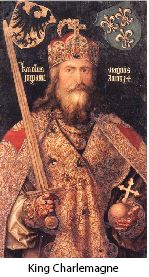 The long years of peace, which King Charlemagne’s wise rule gave to southern France, enabled the people to build a magnificent new church on the site of the old chapel at Apt.
The long years of peace, which King Charlemagne’s wise rule gave to southern France, enabled the people to build a magnificent new church on the site of the old chapel at Apt.
When the day of its consecration arrived (Easter Sunday, 792 A.D.), at the most solemn part of the ceremonies, a boy of fourteen, blind, deaf and dumb from birth — and usually quiet and impassive — to the amazement of those who knew him, completely distracted the attention of the entire congregation by becoming suddenly tremendously excited. He rose from his seat, walked up the aisle to the altar steps, and to the consternation of the whole church, struck his stick resoundingly again and again upon a single step.
His embarrassed family tried to lead him out, but he would not budge. He continued frantically to pound the step, straining with his poor muted senses to impart a knowledge sealed hopelessly within him. The eyes of the people turned upon the emperor, and he, apparently inspired by God, took the matter into his own hands. He called for workmen to remove the steps.
A subterranean passage was revealed directly below the spot, which the boy’s stick had indicated. Into this passage the blind lad jumped, to be followed by the emperor, the priests, and the workmen. They made their way in the dim light of candles, and when, farther along the passage, they came upon a wall that blocked further advance, the boy signed that this also should be removed. When the wall fell, there was brought to view still another long, dark corridor. At the end of this, the searchers found a crypt, upon which, to their profound wonderment, a vigil lamp, alight and burning in a little walled recess, cast a heavenly radiance.
As Charlemagne and his afflicted small guide, with their companions, stood before the lamp, its light went out. And at the same moment, the boy, blind and deaf and dumb from birth, felt sight and hearing and speech flood into his young eyes, his ears, and his tongue.
“It is she! It is she!” he cried out. The great emperor, not knowing what he meant, nevertheless repeated the words after him. The call was taken up by the crowds in the church above, as the people sank to their knees, bowed in the realization of the presence of something celestial and holy.
The crypt at last was opened, and a casket was found within it. In the casket was a winding sheet, and in the sheet were relics, and upon the relics was an inscription that read, “Here lies the body of Saint Anne, mother of the glorious Virgin Mary.” The emperor had an exact and detailed account of the miraculous finding drawn up by a notary and sent to Pope Adrian I. These documents and the pope’s reply are preserved to this day.